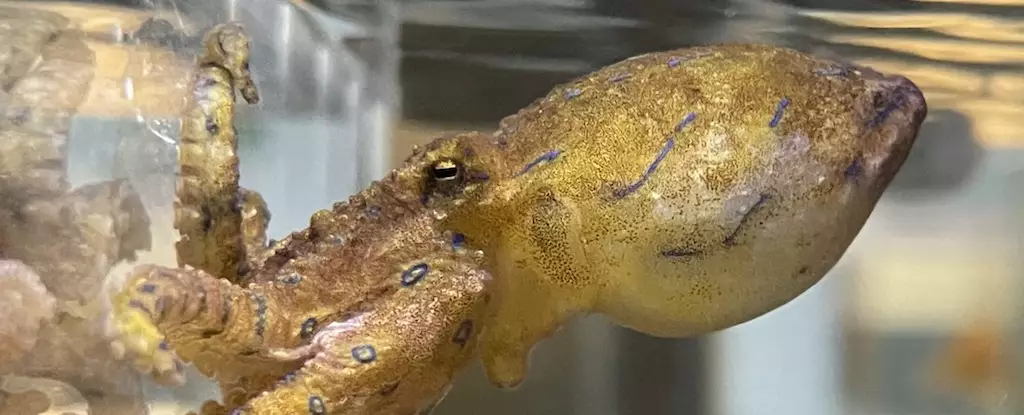When we think of nature’s wonders, beauty and grace often top the list. Yet, lurking beneath this picturesque surface are creatures that defy the romantic notion of the harmonious ecosystem. The blue-lined octopus (Hapalochlaena fasciata) is a prime example of this dark reality. Despite being only a few centimeters long, this diminutive creature harbors one of the deadliest neurotoxins known to mankind: tetrodotoxin (TTX). With a lethal bite that can incapacitate prey and predators alike, the blue-lined octopus embodies a captivating yet terrifying aspect of marine life. This article explores the ingenious, and somewhat sinister, mating strategies of this seemingly inconspicuous marine mollusk, highlighting its vulnerability and inherent dangers.
Deadly Desire: Mating Risks in a Hostile Environment
In the realm of blue-ringed octopuses, sexual dimorphism sets the stage for a perilous dance of survival. Females are nearly twice the size of their male counterparts, creating a profound risk for males hoping to mate. Their biological clock ticks loudly as they pursue reproduction, yet this instinct drives them directly into the jaws of their larger female partners, whose appetites often extend beyond mere reproduction. This raises a fundamental question: at what cost does the male’s desire to procreate come?
To navigate this deadly dynamic, males exhibit an extraordinary survival strategy. Before proceeding with the act of mating, they deploy venom with surgical precision. By delivering a calculated bite near the female’s aorta, the male can briefly paralyze her. This bold maneuver reduces the immediate threat of being devoured. However, it’s chilling to contemplate that this very tactic involves incorporating biochemical weaponry into an intimate act of love.
The Role of Tetrodotoxin: A Double-Edged Sword
Both male and female blue-lined octopuses possess TTX, residing primarily in their saliva. While traditionally perceived as a defense mechanism against predators, this venom also serves a select reproductive purpose. The males have disproportionately heavier salivary glands compared to similarly sized females, amplifying their cocktail of lethality. This physiological specialization suggests an evolutionary arms race, where mating behavior and predation intertwine in a macabre twist of survival.
Interestingly, the mating ritual reveals a disturbing trend in physiological responses. While engaged in copulation, male breathing rates surge, reflecting heightened excitement and engagement. In stark contrast, the female’s breathing slows and ceases altogether for a period. It paints a grotesque picture of vulnerability, akin to a slow-motion train wreck where each moment teeters between ecstasy and peril. The brief loss of control over her own body illuminates the raw power wielded by the males. While they maintain autonomy, the very act of mating blurs the lines between intimacy and enslavement.
Evolution and Resistance: Nature’s Grim Adaptation
The fact that female blue-lined octopuses do not perish during this venomous rendezvous reflects an evolutionary resilience to tetrodotoxin. This ability to tolerate the very substance that paralyzes them speaks volumes about the complexities of co-evolution in nature. It suggests a game of serum and counter-serum, where each adaptation escalates the stakes for survival. One could argue that in the depths of such brutality lies an intricate dance of evolution that defies simple narratives about the beauty of life.
Furthermore, the discovery of physical evidence following mating—swollen lumps and bite wounds—dissects the intimacy of reproduction through the lens of predatory violence. Such findings conjure unsettling imagery; mating, a fundamental biological imperative, morphs into a ritual marked by injury and domination. The intense vulnerability of the females, coupled with the males’ relentless pursuit, evokes uncomfortable questions about the ethics of survival in a predatory world.
The Dance of Life and Death Beneath the Waves
In reflecting on the mating practices of the blue-lined octopus, one might find themselves caught in a moral quagmire. The beauty of life is often intertwined with brutality; the quest for survival morphs into a deadly ballet of instinct and violence. There’s an elegance to this lethal strategy that contradicts our anthropocentric ideals of love and partnership. With each paralyzed female, the creatures reveal the raw and unsettling truths of their existence.
So, as ocean depths cradle these magnificent yet terrifying organisms, the chilling reality of the blue-lined octopus incites a disquieting fascination. In a world where survival often demands sacrificing the sanctity of life and love, the blue-lined octopus stands as a stoic reminder: in nature’s theater, the lines between intimacy and predation are as blurred as the waters they inhabit.


Leave a Reply